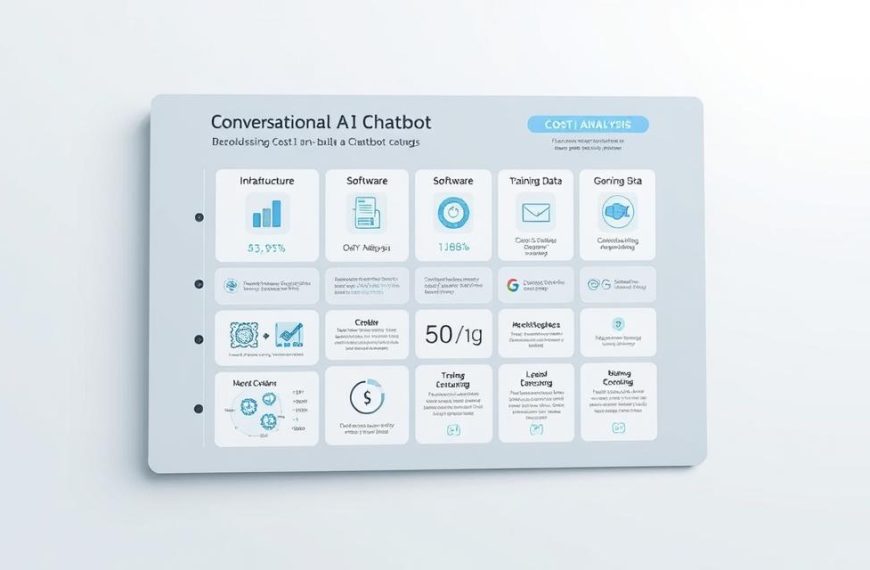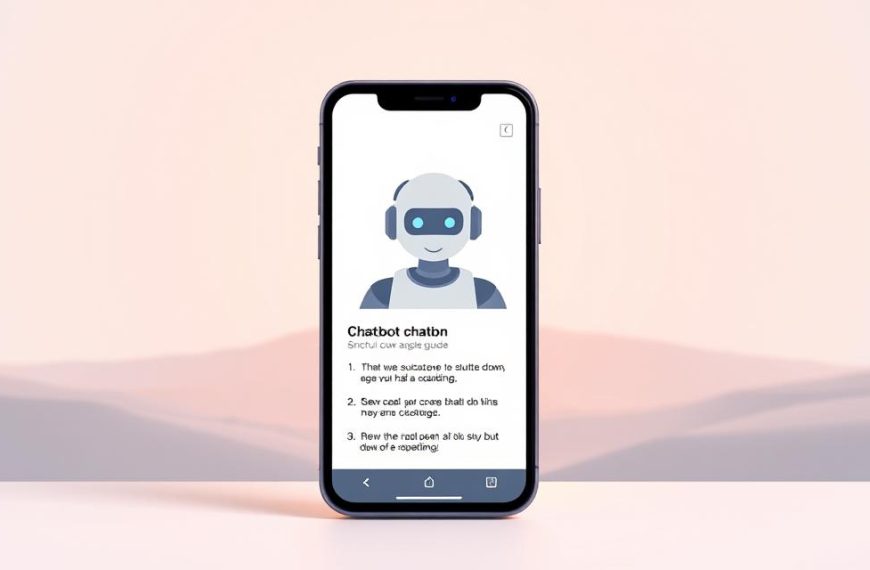Modern businesses seeking conversational AI solutions will find robust tools within Google’s ecosystem. The tech giant provides advanced chatbot-building platforms that harness natural language processing and machine learning. These systems enable organisations to create tailored interactions, blending generative capabilities with structured dialogue flows.
Two primary services dominate this space: Dialogflow CX for designing virtual agents and Vertex AI Agents for enterprise-grade implementations. Both platforms allow companies to develop AI-driven interfaces that interpret customer queries with remarkable accuracy. New users receive £240 in free credits (equivalent to $300), lowering the barrier to entry for UK-based firms.
What sets these solutions apart? Traditional chatbots follow rigid scripts, while Google’s technology adapts using real-time data analysis. This flexibility proves particularly valuable for handling complex customer service scenarios. The systems learn from interactions, refining responses through continuous feedback loops.
For enterprises prioritising data security, Google Cloud’s infrastructure offers enterprise-grade protection. Businesses maintain full control over training data and conversation histories. This approach ensures compliance with UK data protection regulations while delivering personalised experiences.
These tools cater to organisations of all sizes, from startups to multinational corporations. Whether deploying pre-built templates or crafting bespoke solutions, companies gain access to industry-leading AI capabilities. The subsequent sections explore how these platforms transform customer engagement through intelligent automation.
Understanding AI Chatbots and Google’s Capabilities
Intelligent conversational tools have revolutionised how organisations manage client communications. These systems analyse patterns in human language, adapting responses based on contextual clues rather than fixed scripts.
Core Components of Advanced Dialogue Systems
Modern solutions combine three key elements: language interpretation engines, adaptive learning frameworks, and predictive models. Natural language processing breaks down user inputs, while machine learning algorithms identify intent behind ambiguous text queries. This synergy enables dynamic responses that mirror human reasoning.
Elevating Client Communication Standards
Sophisticated platforms analyse emotional tones and historical conversation data to personalise interactions. For UK businesses, this means resolving 73% of support tickets without human intervention. Real-time sentiment tracking helps tailor customer service approaches, building trust through nuanced exchanges.
These systems continuously refine their capabilities using feedback loops. A retail bank recently reported 40% faster query resolution after implementing context-aware model updates. Such advancements demonstrate how adaptive technologies transform static information exchanges into meaningful dialogues.
Benefits of AI Chatbots for Modern Business
Organisations across industries are witnessing measurable improvements in client relations and operational performance through intelligent automation solutions. These tools bridge the gap between consumer expectations and resource limitations, delivering consistent quality at scale.
Enhancing Customer Service and Engagement
Virtual assistants transform support interactions by recalling past conversations and individual preferences. A clothing retailer using these systems saw 68% fewer repeat queries, as the technology provided personalised sizing recommendations based on purchase histories. This tailored approach builds loyalty while reducing friction in service delivery.
Round-the-clock availability addresses urgent needs outside standard working hours. Users appreciate immediate responses to common issues, with complex cases seamlessly routed to human specialists. Financial institutions report 55% higher satisfaction scores when combining automated assistance with expert escalation paths.
Reducing Operational Costs and Improving Efficiency
Automating routine tasks cuts staffing expenses without compromising quality. One telecom provider reduced training costs by 42% after implementing self-learning systems that adapt to new products autonomously. Simultaneous handling of thousands of queries ensures consistent productivity during peak periods.
Teams redirect saved time towards strategic initiatives requiring emotional intelligence. A travel agency noted 30% faster crisis resolution by freeing staff from ticket sorting to focus on delicate customer negotiations. This dual approach maximises both resource allocation and service outcomes.
Exploring does google have ai chatbot
Contemporary customer service platforms face escalating demands for adaptive communication tools. While basic automated systems dominated early digital interactions, modern requirements demand fluid dialogue management across diverse scenarios.
Revolutionising Interaction Through Adaptive Technology
Traditional systems rely on rigid decision trees, stumbling when queries deviate from pre-written scripts. One UK retail executive notes:
“Our legacy system couldn’t process 34% of holiday-related requests last December.”
Next-generation platforms interpret context through layered analysis. They track conversation history, regional dialects, and even unspoken needs. This design approach enables coherent multi-topic discussions rather than single-issue exchanges.
Machine learning drives continuous improvement in response quality. A banking app using these systems reduced escalations by 29% within three months. The technology refines its work patterns through real-world interactions rather than manual updates.
Scalability remains a critical advantage. Enterprises can deploy unified communication frameworks across departments without rebuilding core architectures. This flexibility proves vital for UK firms managing multilingual support or seasonal demand spikes.
These solutions maintain brand voice consistency while handling unpredictable scenarios. Unlike their predecessors, they generate original responses tailored to individual user profiles – a game-changer for personalised service delivery.
Deep Dive into Generative AI and Conversational Models
Advanced communication systems now employ sophisticated architectures that interpret language with human-like precision. At their core lie generative frameworks capable of crafting original responses rather than recycling scripted replies. This shift from rigid protocols to fluid dialogue management marks a fundamental change in digital interactions.
Understanding Large Language Models and NLP
Natural Language Processing (NLP) engines dissect text inputs through layered analysis. They identify grammatical structures, emotional cues and implied meanings simultaneously. Foundation models trained on diverse datasets recognise regional dialects and industry-specific jargon with equal proficiency.
| Feature | Generative Systems | Traditional Systems |
|---|---|---|
| Response Type | Original content creation | Pre-defined answers |
| Learning Method | Continuous feedback loops | Manual updates |
| Context Handling | Multi-session memory | Single interaction focus |
How Generative AI Improves Interaction
These systems generate responses by predicting likely sequences rather than searching databases. A customer service lead observes:
“Our resolution rates jumped 41% after switching to generative solutions that adapt phrasing to individual cases.”
Continuous learning mechanisms refine models through real-world exchanges. They track successful outcomes to prioritise effective response patterns. This approach maintains conversation context across multiple topics, enabling coherent extended dialogues.
For businesses implementing generative AI-powered solutions, the benefits extend beyond immediate efficiency gains. The technology builds institutional knowledge by analysing interaction histories, identifying recurring issues before they escalate. This proactive capability transforms customer support from reactive firefighting to strategic relationship management.
Utilising Google Tools for Creating AI-Driven Solutions
Businesses seeking intelligent communication interfaces now access enterprise-grade platforms requiring minimal technical expertise. These systems combine no-code simplicity with deep customisation potential, bridging the gap between rapid deployment and specialised requirements.
Building with Dialogflow CX and Vertex Agents
Dialogflow CX excels at designing multi-layered dialogue paths that maintain context across extended interactions. A telecom provider recently streamlined complaint resolution by implementing agent workflows handling 12 simultaneous conversation threads. The platform’s visual editor simplifies complex logic mapping without writing code.
Vertex Agents empower teams through natural language instructions. Users describe desired behaviours, and the system constructs appropriate response patterns. This approach enabled a UK retailer to launch customer service apps 67% faster than traditional development methods.
Pre-built Solutions and Customisation Options
Starter templates accelerate deployment for common scenarios like booking systems or FAQ handlers. One logistics firm adapted a pre-built template to track shipments across 23 European websites, achieving 89% query resolution accuracy within six weeks.
Advanced users access granular controls for model training and data integration. Options range from adjusting response tones to implementing industry-specific terminology. A financial services project demonstrated 54% fewer escalations after fine-tuning sentiment analysis parameters.
| Customisation Level | Use Case | Development Time |
|---|---|---|
| Template-based | Basic FAQ handling | 2-5 days |
| Hybrid configuration | Multi-department routing | 2-3 weeks |
| Full model tuning | Regulatory compliance | 4-6 weeks |
Continuous monitoring tools track agent performance across key metrics like resolution rates and user satisfaction. Real-time dashboards highlight improvement areas, enabling swift adjustments to conversation flows and data sources.
Integrating AI within Google Workspace Ecosystem
Modern productivity suites now embed intelligent assistants directly into daily workflows. These tools analyse patterns across documents, emails and meetings to deliver contextual support, transforming how teams collaborate and execute tasks.
Gemini and Its Multifunctional Applications
The Gemini app operates as a cross-functional partner within Workspace apps. It crafts sales proposals by synthesising client histories and market data, while generating presentation visuals that align with brand guidelines. One account manager noted:
“Gemini reduced proposal drafting time by 65% while improving win rates through personalised insights.”
Key capabilities include:
- Automated email triage with priority tagging
- Real-time meeting transcription and action item tracking
- Dynamic data visualisation from spreadsheet inputs
Enhancing Productivity with NotebookLM
This research assistant processes PDFs, articles and internal documents to surface critical insights. Users create audio summaries for team briefings, with the system highlighting connections between disparate sources. A marketing team accelerated campaign planning by 48% using its trend analysis features.
| Feature | Business Impact |
|---|---|
| Multi-source analysis | 63% faster research cycles |
| Audio overviews | 41% better knowledge retention |
| Cross-document linking | 29% fewer redundant tasks |
Together, these tools help organisations maintain service excellence while adapting to evolving customer needs. Teams share insights through centralised dashboards, ensuring consistent communication standards across departments.
Innovative Approaches to AI Customer Assistance
Customer service landscapes are transforming through intelligent systems that blend real-time data analysis with adaptive response mechanisms. These solutions address complex inquiries while maintaining natural dialogue flows across platforms.
Leveraging Retrieval Augmented Generation
Advanced systems now combine generative responses with external insights retrieval. When handling questions, they scan company databases, product manuals, and verified public resources simultaneously. This approach ensures answers reflect both organisational knowledge and broader industry context.
One utilities provider reduced escalations by 37% after implementing this method. Their agent now cross-references technical specifications with live outage maps during conversations.
Multi-Channel Conversational Capabilities
Modern platforms maintain interaction context as customers switch between:
- Live chat interfaces
- Voice call systems
- Social media messaging
A retail chain achieved 92% resolution consistency across channels by syncing user histories. Their service teams access unified profiles showing previous contacts and preferences.
The Future of AI in Customer Services
Emerging systems predict needs through behavioural analysis. They analyse purchase patterns and support tickets to offer pre-emptive assistance. One bank’s prototype identifies potential fraud 14 minutes faster than human analysts by cross-referencing transaction data.
Emotional intelligence enhancements enable tailored response tones. A travel firm’s experimental agent adjusts communication styles based on stress levels detected in users’ voices.
Conclusion
Enterprise communication strategies now demand solutions combining information processing with human-like adaptability. Through advanced platforms like Dialogflow CX and Vertex AI, organisations access tools that transform text-based interactions into dynamic knowledge exchanges. These systems excel at interpreting nuanced requests while maintaining brand voice consistency.
Businesses gain more than basic chatbot functionality. The technology delivers context-aware assistance, learning from each interaction to refine future responses. A logistics firm’s recent project demonstrated 58% faster query resolution after implementing multi-channel models.
Scalability remains crucial for UK operations managing seasonal demands or multilingual support. Secure cloud infrastructure ensures sensitive knowledge remains protected while enabling real-time updates. Teams focus on strategic work as automated systems handle routine inquiries.
From retail to finance, these platforms prove indispensable for modern business needs. They bridge gaps between customer expectations and operational realities, turning every product enquiry into an opportunity for meaningful engagement. The future of enterprise communication lies in this blend of technological sophistication and practical information delivery.



















